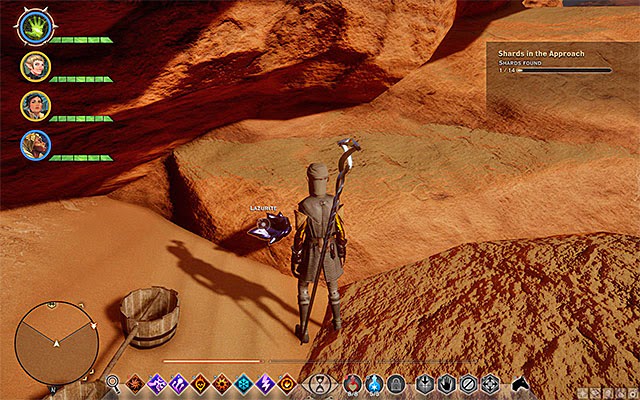How to Unlock: Meet with the Requisition Officer.
Quest-Giver: Requisition Officer (M19,2)

Lazurite Ore
The Requisition Officer in one of the camps (M19,2) can assign the quest (these jobs appear in a random order). He’ll provide you with the recipe and request that you collect the following resources:
- 20 units of Paragon’s Luster – These rocks are rare and can be found in the Western Approach, so check the area carefully.
- 10 units of Lazurite – Also rare, explore mostly the caves and hills.
Once the items have been collected, return to the camp and use the table to complete the job.
Rewards for completing the quest:
- Experience (not much)
- 200 Influence Points
- 1 power point
- Recipe: Western Approach Geological Survey
FAQ
1. What is Lazurite Survey and what is its purpose in the Approach?
Lazurite Survey is a scientific research project that aims to study the mineralogy and geology of the Approach, a region in the Arctic Ocean. The project focuses on the study of the mineral lazurite, which is found in the Approach in large quantities. The purpose of the survey is to better understand the formation and evolution of the Arctic Ocean and the role that lazurite plays in this process. The study will also provide valuable information about the geology and mineralogy of the Arctic region, which is important for understanding the Earth’s history and future.
2. Who is conducting the Lazurite Survey and what are their qualifications?
The Lazurite Survey is being conducted by a team of scientists from several countries, including Russia, Canada, and the United States. The team includes geologists, mineralogists, and oceanographers, all of whom are highly qualified in their respective fields. The project is led by Dr. Ivan Petrov, a renowned geologist from Russia, who has extensive experience in studying the geology and mineralogy of the Arctic region. The team also includes several junior researchers and graduate students, who are gaining valuable experience in conducting scientific research.
3. How is the Lazurite Survey being conducted?
The Lazurite Survey is being conducted using a variety of scientific instruments and techniques. The team is using a remotely operated underwater vehicle (ROV) to collect samples of the sediment and rocks from the seafloor. They are also using sonar and other imaging technologies to map the seafloor and identify areas of interest for further study. The team is also analyzing the samples in the laboratory using a variety of analytical techniques, including X-ray diffraction and electron microscopy. This allows them to identify the mineralogy and chemistry of the samples and better understand the geological processes that formed them.
4. What are the potential applications of the Lazurite Survey’s findings?
The Lazurite Survey’s findings have the potential to provide valuable insights into the geological and mineralogical processes of the Arctic region. This information can be used to better understand the history and evolution of the Earth, as well as to inform future exploration and development of the Arctic region. The study of lazurite, in particular, has potential applications in the development of new materials and technologies, such as superconductors and advanced electronics. The Lazurite Survey’s findings may also have implications for the study of similar geological processes in other parts of the world.
5. What are the potential risks associated with the Lazurite Survey?
The Lazurite Survey is being conducted with the utmost care and attention to safety and environmental concerns. However, there are still potential risks associated with the project, particularly with the use of the ROV and other equipment in the Arctic environment. There is also a risk of disturbing the fragile ecosystem of the Arctic Ocean and causing damage to the seafloor and its inhabitants. The Lazurite Survey team is taking steps to minimize these risks, including working closely with local communities and environmental organizations to ensure that the project is conducted in a responsible and sustainable manner.

James, a young and enthusiastic gamer. With a passion for gaming, he personally plays and experiences the games he writes about, providing authentic and insightful content to fellow gamers.
